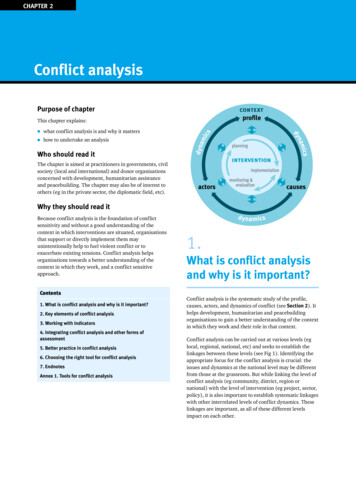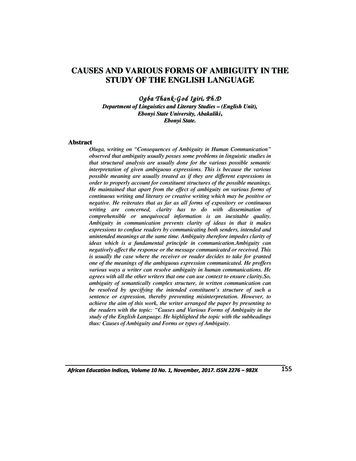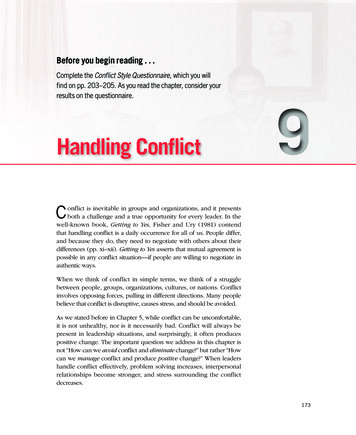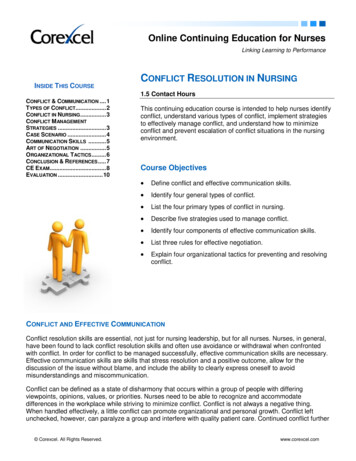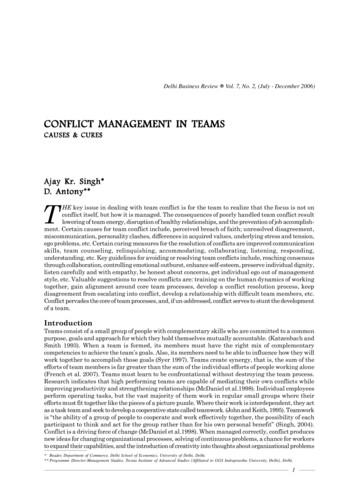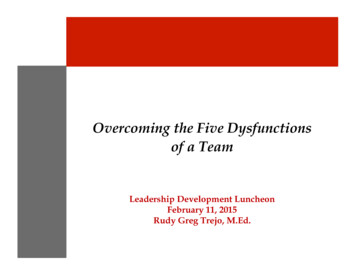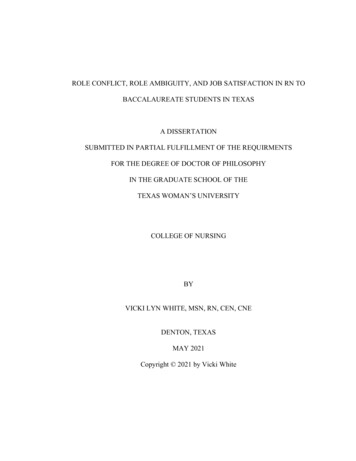
Transcription
ROLE CONFLICT, ROLE AMBIGUITY, AND JOB SATISFACTION IN RN TOBACCALAUREATE STUDENTS IN TEXASA DISSERTATIONSUBMITTED IN PARTIAL FULFILLMENT OF THE REQUIRMENTSFOR THE DEGREE OF DOCTOR OF PHILOSOPHYIN THE GRADUATE SCHOOL OF THETEXAS WOMAN’S UNIVERSITYCOLLEGE OF NURSINGBYVICKI LYN WHITE, MSN, RN, CEN, CNEDENTON, TEXASMAY 2021Copyright 2021 by Vicki White
DEDICATIONTo Danny White, my fabulous husband, Brent Evans, my son, Mary Overton, mymother, and Margaret Evans, who is like a second mother, thank you all for theencouragement, belief in my ability to finish, and the support each of you gave. I could nothave completed my dissertation without each and every one of you. My husband, son,mother, and second mother kept me going during times I was frustrated and very tired.ii
ACKNOWLEDGEMENTSI would like to acknowledge the individuals that have contributed to thisdissertation. Without their encouragement, support, and guidance, I would not have comethis far. First, I would like to thank Dr. Elizabeth Restrepo, who served as my thirdcommittee chair. Your guidance and suggestions have made my dissertation possible. Iappreciate all of the long hours you worked with me on Zoom to complete my chapters.Second, I would like to thank Dr. Donna Scott-Tilley, who has been on my committeesince it began. Your suggestions are always on point and I will miss your support nowthat my program is complete. Third, I would like to thank Dr. Patricia Hamilton, mysecond dissertation chair, for adding me on as your student when my first committeechair resigned. You were so helpful to me when I was getting started and I appreciateyou so much. I also have to express my thanks to Dr. Marge Benham-Hutchins. Her helpin revising my topic was invaluable and gave me a new direction that I became veryinterested in. The friendships made during this program have helped to keep me positiveand helped to remind me that I could do this!iii
ABSTRACTVICKI LYN WHITEROLE CONFLICT, ROLE AMBIGUITY, AND JOB SATISFACTION IN RN TOBACCALAUREATE STUDENTS IN TEXASMay 2021Background: The Institute of Medicine (2011) recommended that nurses attain higherlevels of education at the baccalaureate level and above to assume roles as providers,researchers, educators, and leaders to impact health policy. The purpose of this study wasto examine the relationships among role conflict, role ambiguity, and job satisfaction inRN to BS/BSN students in Texas.Method: A cross-sectional correlational design was used to: (a) determine therelationships among role conflict, role ambiguity, and job satisfaction; (b) the ability ofrole conflict and role ambiguity to predict job satisfaction; and (c) to determine therelationship between descriptive variables and role conflict, role ambiguity, and jobsatisfaction. Participants in three RN to BS/BSN programs in Texas completed a surveyin PsychData that included the tools: (a) Role Conflict and Role Ambiguity Scale, (b) JobSatisfaction Index, and (c) demographic questions created by the researcher. The totalnumber of participants was 87. Spearman’s nonparametric rank order correlation wasused to determine the direction and strength of relationships between role conflict, roleambiguity, and job satisfaction. Hierarchical multiple regression was used to add thevariables role conflict and role ambiguity to determine the model’s ability to predict jobiv
satisfaction, while controlling for age in groups, gender, marital status, race/ethnicity,number of nursing course hours in the current semester, and hours worked per week.Results: Findings indicated there was a moderate negative relationship between roleconflict and job satisfaction indicating that as participants’ role conflict increased, jobsatisfaction decreased. There was a moderate positive relationship between roleambiguity and job satisfaction, which indicated as role ambiguity increased, jobsatisfaction increased. Analyses revealed a moderate negative relationship between roleconflict and role ambiguity, indicating that as role conflict increased, role ambiguitydecreased. Using hierarchical multiple regression, the researcher found that roleambiguity and role conflict were significantly predictive of job satisfaction. Lower roleconflict and higher role ambiguity predicted higher job satisfaction.Conclusions: As participants’ role conflict increases, job satisfaction decreases. As roleambiguity increases, job satisfaction increases. As role conflict increases, role ambiguitydecreases. Role conflict and role ambiguity significantly predict job satisfaction. Roleconflict has a negative effect on job satisfaction and role ambiguity has a positive effecton job satisfaction.v
TABLE OF CONTENTSDEDICATION . iiACKNOWLEDGEMENTS . iiiABSTRACT. ivLIST OF TABLES . ixLIST OF FIGURES . xChapterI. INTRODUCTION . 1Problem of Study . 1Rationale for the Study . 4Theoretical Framework . 5Proposition 1 . 6Proposition 2 . 7Proposition 3 . 7Proposition 4 . 7Assumptions. 9Research Questions . 10Definition of Terms. 10Limitations . 12Internal Validity . 12External Validity . 13Summary . 14II. LITERATURE REVIEW. 15Role Conflict and Role Ambiguity . 16Job Satisfaction . 34Conclusion . 42III. PROCEDURE FOR COLLECTION AND TREATMENT OF DATA . 43Setting . 43Population and Sample . 43Protection of Human Subjects . 45Instruments . 47Validity . 48Reliability. 48Data Collection . 50vi
Treatment of Data . 50Summary . 53IV. ANALYSIS OF DATA . 54Description of the Sample. 54Income. 57University Information. 58Experience. 60Work Status and Hours Worked per Week . 60Financial Support and Employment Locations . 63Magnet Status and Return to School. 63Reliability of the Survey Instruments . 66Additional Analysis . 67Role Conflict by Income . 67Role Ambiguity by Income. 70Job Satisfaction by Income . 70Role Conflict, Role Ambiguity, and Job Satisfaction by Course HoursCompleted . 71Findings. 72Research Question 1 . 72Research Question 2 . 76Research Question 3 . 79Research Question 4 . 81Research Question 5 . 86Role Conflict by Age in Groups . 86Role Conflict by Gender . 87Role Conflict by Marital Status Groups. 88Role Conflict by Race/Ethnicity . 88Role Ambiguity by Age in Groups . 91Role Ambiguity by Gender . 91Role Ambiguity by Marital Status Groups . 92Role Ambiguity by Race/Ethnicity . 93Job Satisfaction by Age in Groups. 95Job Satisfaction by Gender . 95Job Satisfaction by Marital Status. 96Job Satisfaction by Race/Ethnicity . 96Summary of the Findings . 99V. SUMMARY OF THE STUDY . 101Discussion of the Findings . 102Conclusions and Implications . 107Study Limitations . 110vii
Recommendations for Further Study . 112Summary . 113REFERENCES . 114APPENDICESA. Recruitment Email . 124B. Recruitment Flyer . 126C. Informed Consent Form . 128D. Role Conflict and Role Ambiguity Scale. 131E. Job Satisfaction Index. 133F. Demographic and Other Questions . 135G. Permission to Use Role Conflict and Role Ambiguity Scale. 138H. Permission to Use the Job Satisfaction Index . 140I. IRB Approval . 142J. IRB Extension . 144viii
LIST OF TABLESTablePage1. Demographic Information. 562. Participants' Number of Children and Age Ranges of Children . 573. Family Income . 584. Number of Hours in Current Semester and Hours Completed in RN to BS/BSNProgram . 595. Participants Nursing Experience . 616. Work Status, Hours Worked per Week, and Shifts Work . 627. Financial Support and Employment Location . 648. Magnet Status and Reasons for Returning to School. 659. Reliabillity of Instruments . 6710. Welch's F Results for Role Conflict, Role Ambiguity, and Job Satisfaction byIncome Group . 6911. Tests of Normality . 7412. Correlations between Role Conflict, Role Ambiguity, and Job Satisfaction. 7613. Summary of Hierarchical Multiple Regression Analysis PredictingJob Satisfaction . 8514. Welch's F Means and Standard Deviations for Role Conflict by Age in Groups,Gender, Marital Status, and Race/ethnicity . 9015. Welch's F Means and Standard Deviations for Role Ambiguity by Age in Groups,Gender, Marital Status, and Race/ethnicity . 9416. Welch's F Means and Standard Deviations for Job Satisfaction by Age in Groups,Gender, Marital Status, and Race/ethnicity . 98ix
LIST OF FIGURESFigurePage1. Scatterplot for Role Conflict and Job Satisfaction. 752. Scatterplot for Role Ambiguity and Job Satisfaction . 783. Scatterplot for Role Conflict and Role Ambiguity . 804. Histogram of Job Satisfaction Scale Sum . 835. Probability-Probability (P-P) Plot of Regression Standardized Residual forDependent Variable Job Satisfaction . 846. Residual Plot for Hierarchical Multiple Regression . 867. Model of Conclusions . 109x
CHAPTER IINTRODUCTIONNearly 20% of the population of the United States (US) will be 65 years of age orolder by the year 2030 (Institute of Medicine [IOM], 2011). With this increase in theelderly population, healthcare will face an increase of patients with chronic diseases andcomplex needs (IOM, 2011). To meet patient needs, the IOM recommends that nursesattain higher levels of education, at the baccalaureate level and above, in order toeffectively assume roles as providers, researchers, educators, and leadership; and toimpact health policy. The goal of this study was to examine the relationship between roleconflict, role ambiguity, and job satisfaction in Registered Nurse (RN) to Bachelor ofScience/Bachelor of Science in Nursing (BS/BSN) students in Texas.Problem of StudyThe IOM (2011) report, The Future of Nursing: Leading Change, AdvancingHealth, calls for 80% of nurses to be BS/BSN-prepared by 2020. To meet the goal ofincreasing the number of BS/BSN prepared nurses, the IOM (2011) recommendsassociate degree nurses return to school for their BS/BSN degree within five years ofinitial licensure and for community colleges to educate students about how to continuetheir education. According to the Health Resources and Services Administration (HRSA)(2018), there were approximately 3,067,000 RNs in the US workforce in 2018. As of1
2018, 56% of RNs in the US had earned BS/BSN or higher degrees, which was anincrease from 49% in 2010 (American Association of Colleges of Nursing [AACN],2019). As of 2019, the number of nurses prepared at the BS/BSN or higher level in Texashad increased to 66% (Texas Department of State Health Services Texas Center forNursing Workforce Studies, 2019). New York Governor Andrew Cuomo signed a lawrequiring RNs to achieve a BSN or higher within 10 years of initial licensure inDecember of 2017 (Newland, 2018). In 2012, the American Nurses Association affirmedthat the organization supports “BSN in 10” as long as the entry to practice level remainsat the associate or diploma level for RNs (Larson, 2012). While the number of nurseswith BS/BSN and higher degrees has increased, the number still has not reached 80%(AACN, 2019).Magnet Recognition status, a designation awarded by the American NursesCredentialing Center (ANCC), is recognition of transformational leadership, structuralempowerment, exemplary professional practice, new knowledge, innovation, andimprovements, and empirical quality results (2019). For hospitals seeking MagnetRecognition or re-designation, 100% of nurse leaders must have a bachelor’s degree orhigher and the Chief Nursing Officer must have a minimum of a master’s degree (ANCC,2019). As of 2021, there were 51 hospitals in Texas and 545 hospitals in the US withMagnet Recognition (Nurse.com, 2021). Some hospitals with the designation or seekingthe designation require or prefer to hire nurses with at least a BS/BSN degree in nursing(AACN, 2019; Boyd, 2011; Trossman, 2012).2
These initiatives have resulted in an increased number of nurses returning to schoolto obtain their BS/BSN degree (Texas Department of State Health Services Texas Centerfor Nursing Workforce Studies, 2019). To help increase the number of BS/BSN-preparednurses, community colleges and universities work together to provide for a seamlessprogression for RNs who return to obtain their BS/BSN degree (Academic Progression inNursing [APIN], 2021; Fairman & Meyer, 2014; Sportsman & Allen, 2011). The RobertWood Johnson Foundation awarded a grant to the Texas Team Action Coalition for thefirst phase of the APIN program in 2012 and awarded a second grant for the second phasein 2014. The goal of the APIN grant was to help Texas increase the number of BS/BSNnurses to 80% by 2020 (APIN, 2021). According to the Texas Department of State HealthServices Texas Center for Nursing Workforce Studies (2019), 66% of nurses in Texashad earned a BS/BSN or higher level of education.Many RNs who return to school to obtain a BS/BSN degree continue to work fulltime and fulfill other roles in their families and communities (Haggard-Duff, Bogulski,Rainey, Mcelfish, & McSweeney, 2020; Hood, 2014). The stresses from this additionalstudent role may cause increased role conflict or role ambiguity as well as changes in jobsatisfaction (Dick & Anderson, 1993; Wu & Norman, 2006). Role conflict occurs when aperson experiences conflicting sets of expectations or demands within one role in anorganization which can lead to decreased satisfaction (Rizzo, House, & Lirtzman, 1970).Role ambiguity occurs when a person does not have enough information to effectively3
complete the expectations of a role within an organization and can lead to dissatisfaction,anxiety, and decreased performance (Rizzo et al., 1970).Rationale for the StudyNurses have numerous responsibilities related to their professional and personallives (Haggard-Duff et al., 2020; Moustaka & Constantinidis, 2010; Stanley, 2006).There are times when the actions in each of these roles may conflict. Prior to returning toschool, nurses may not truly understand school expectations or the time necessary tocomplete coursework such as readings, discussions (if online), class time (if face-to-face),projects, or written assignments (Duchscher & Myrick, 2008; Haggard-Duff et al., 2020).Students are often unprepared for the time demands and faculty expectations thatassignments must be completed regardless of other responsibilities (Gormley, 2003;Gormley & Kennerly, 2011; Haggard-Duff et al., 2020). Students generally retainexisting roles at home and work but add the student role without reduction in otherresponsibilities (Braunstein-Bercovitz, 2013; Xu & Song, 2013). Decisions regardingcompletion of coursework based on their time commitments can lead to poorperformance, stress, or exhaustion (Deimann & Bastiaens, 2010).Role conflict or role ambiguity can occur between any of the nurse’s roles (a) theemployee role, (b) parent and/or child/family role, (c) student role, and (d) communityrole (Braunstein-Bercovitz, 2013; Xu & Song, 2013). Competing demands from differentroles can result in role conflict. When role expectations are not clear between one or moreroles, role ambiguity can occur. Long hours plus physical and emotional exhaustion from4
work, in addition to the demands of school, can interfere with family obligations such aschildcare or attending children’s events at school. Nurses who return to a student roleoften have issues dealing with their other role obligations such as the employee role andparent and/or child/family role due to a limited amount of time to complete all tasks(Dick & Anderson, 1993). Also, the nurse returning to school may not have a clear ideaof the time needed to complete school activities, which can lead to role ambiguity. Achoice often must be made to focus on one role to the detriment of the other roles. Thepurpose of this cross-sectional, correlational research study was to examine therelationships among the primary study variables of role conflict, role ambiguity, and jobsatisfaction in RN to BS/BSN students in Texas.Theoretical FrameworkRole theory (Biddle, 1986) is the framework for this study. According to Biddle,“role theory is a science concerned with the study of behaviors that are characteristic ofpersons within contexts and with various processes that presumably produce, explain, orare affected by those behaviors” (p. 4). The underlying propositions of role theory arethat (a) behaviors may be distinctive within certain situations; (b) behaviors may beassociated with common identities or social positions; (c) behaviors may be guided byexpectations or consequences; and that (d) people must be taught roles that may lead todiffering feelings, such as joy or sorrow, when acting in those roles. According to Biddle(1986), specific roles are related to social positions such as physicians writingprescriptions or teachers lecturing a class. Each status carries with it certain expected5
actions or behaviors. Expected behaviors for each role are learned through specificeducation for the role or by experience within the role. Some roles have formal explicitwritten expectations while others may have implied expectations. Formal explicit writtenexpectations can be in the form of job descriptions, however, all actions expected withina job role may not be listed (Biddle, 1986). Roles with implied expectations may befunctions within social systems such as a role as parent or grandparent.Each role a person fills includes responsibilities and behaviors that are essential tomeeting expectations (Biddle, 1986). When one has a number of roles to fulfill, he or sheoften adapts or changes roles based upon alternating responsibilities for work, school,family, and community (Biddle, 1986). Knowing that specific behaviors are expectedwithin each role can help one to identify role conflicts that may occur when one mustfulfill several roles or identify role ambiguity if unclear expectations exist within one ormore roles. There are four propositions or beliefs about role theory.Proposition 1: If there are distinctive behaviors for each role then students willhave certain perceptions of the behaviors necessary for each roleIn order to determine role conflict and role ambiguity, one must first look at theroles that students fulfill. Based upon the first proposition, that behaviors may bedistinctive within certain situations, for each role a person may fill, he or she will haveperceptions about role expectations and the behaviors necessary to fulfill that role. Thedemographic and other survey questions will determine the different roles participants fillwhich could lead to role conflict or role ambiguity and affect job satisfaction.6
Proposition 2: If there are different roles someone must fill, there will be differentbehavior expectations for each roleThe second proposition that behaviors may be associated with common identities orsocial positions, again utilizes the demographic questions to determine what role orpositions participants fill. Expected behaviors in the workplace are different thanbehaviors expected at home and the addition of the student role could lead to role conflictor role ambiguity. In addition, in the work or the home role, the student is the person incharge of his or her actions, and often providing education or other information forpatients or for their own family members. When the student steps into the learner role theprofessor becomes the person in charge.Proposition 3: If there are different behaviors for each role, then expectations orconsequences may guide behaviorsWith Proposition 3, behaviors may be guided by expectations or consequences. Thestudy participants will provide information about the differing roles they fulfill which canshed light on behaviors necessary for each role and the possible conflict that may becaused when one role must take precedence over another role.Proposition 4: If different behaviors are expected for each role, people must betaught specific expectationsWith Proposition 4, people must be taught roles that may lead to differing feelingssuch as joy or sorrow when acting in those roles. Survey questions about different roles7
the participants fill in addition to the student role can be used to determine therelationship between those roles and role conflict and role ambiguity. This leads tosurvey questions about role conflict and role ambiguity as the participant is taught how tobehave in the student role. One result of these conflicting feelings from acting in differentroles could be role ambiguity or job dissatisfaction. The conflicting feelings can also leadto withdrawal from school because of lack of joy in coursework or changing jobs due tohard feelings from conflict at work.Students must frequently adapt or change their roles based upon alternatingresponsibilities in other roles (Hood, 2014). Issues with job satisfaction can then arisewhen the student experiences role conflict, competing demands between roles, or roleambiguity, and when expectations from employers, family, or school are unclear. Whenthe student has difficulty or is unable to make the adaptations involved with thefrequently changing roles, or when one role demands more than the student can give, heor she can develop role conflict (Hood, 2014). Role theory provided a framework forunderstanding the different roles nurses may fulfill between work, home, family, orschoo
role conflict, role ambiguity, and job satisfaction in rn to baccalaureate students in texas . a dissertation . submitted in partial fulfillment of the requirments . for the degree of doctor of philosophy . in the graduate school of the . texas woman's university . college of nursing . by . vicki lyn white, msn, rn, cen, cne . denton, texas .
